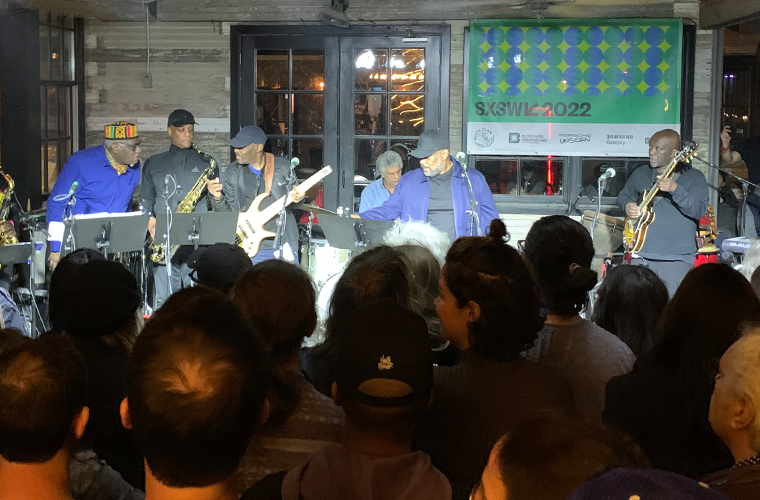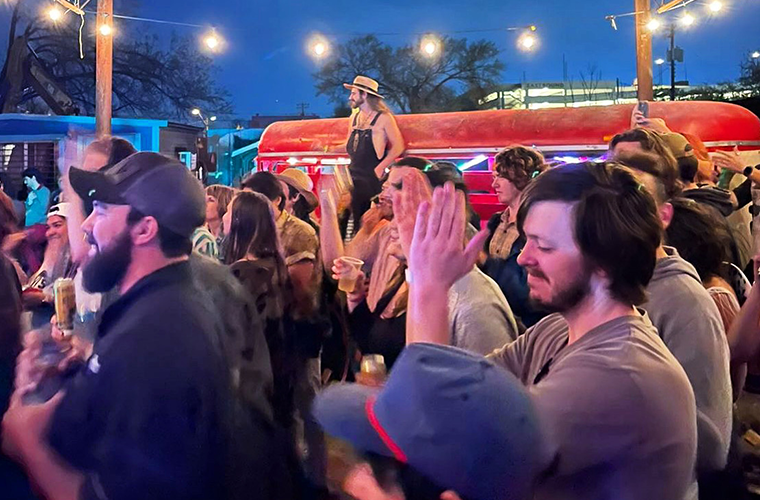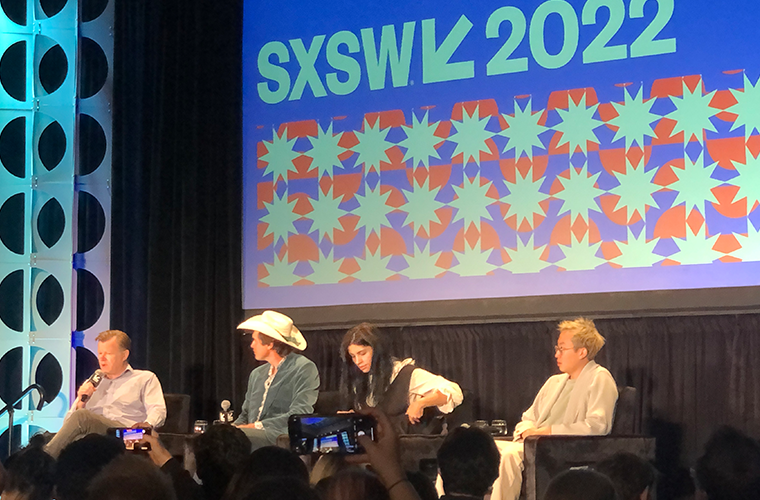Armed with a press badge, I took #SXSW22 in stride, dabbling in film, interactive, and musical offerings for KOOP. Back was the thrill of hailing pedicabs, cutting lines (and also waiting in them), pounding the pavement to catch bands all over town, stomach full of free tacos and beer. As familiar as it all felt, there were growing pains as SXSW finds its wings under new ownership and an Austin changed by the past few years.
While there are opportunities for improvement (investing in sound! better outdoor venues! more diverse panelists! crowd control!), I think all would agree that SXSW’s revival was a success for the city. A few trends and takeaways stand out as South By’s shadow starts to fade—read on for some legendary musical reunions, a spotlight on local Austin superheroes, and why the ubiquitous conversation about web3 fell short.
Listen to our SXSW playlist as you go!

1. Revival stories all around
While SXSW was on its own revival path, many musicians were also hitting the road after a few years- or a few decades- away. I was honored to be at performances by no less than 3 bands (Cymande, WITCH, and Ural Thomas and the Pain) whose winding paths through music deserve their own documentaries. One of those groups did come to SXSW as the subject of the world premiere documentary feature from Tim Mackenzie-Smith—Getting it Back: The Story of Cymande. The film was goosebump-raising, enriching Cymande’s live performance with a fascinating backstory.
Cymande (pronounced sigh-mahn-day) is a calypso-inspired funk group formed in England in the early 1970s. With their undefinable fusion of sounds—owed, in part, to their Caribbean roots—the group’s music came to fame via a tour with Al Green in the USA. Not long after, the band split and went on with their lives in Brixton, London, where they were essentially unknown. Their records, however, lived on on American airwaves: the hypnotic rhythms they contained eventually became essential samples in the formative days of hip hop and disco. In Getting it Back, DJs from Jazzy J to De La Soul speak reverently of Cymande’s self-titled 1972 record, calling it the most influential album of their early careers.
Fast-forward to Friday night of the fest, on Rainy Street: a hip crowd—some aware of the mystical status of the band and some just drinking—gathered in the cramped backyard of Lucille’s. Those in the know laughed at the randomness of a mid-sized cocktail bar hosting a group of certified legends. When Cymande took the stage, all of lost our minds to the tune of “Bra” (a song that you would almost certainly recognize by sample if not in its original form). The fusion of all the instruments—bongos to saxophones to the most wandering of bass lines—was a taste of magic that the documentary hammered home.
Another revival group played the same bill that night, lucky audience members pinching themselves all the while. WITCH (We Intend To Cause Havoc), was the quintessential band of Zamrock, an afro-psychedelic genre born in the 1970s in Zambia. Original members Emanuel “Jagari” Chanda and Patrick Mwondela performed dressed in traditional African fabrics alongside a group of Tame Impala-esque session rockers. They enraptured the 1am crowd with a fuzzy, percussive set, dressing up the lo-fi tracks from across their 10-year-long discography.
I also tagged on a quick visit to San Jose to see Ural Thomas and the Pain, whom I previewed for KOOP. The soul-and-funk, gospel-tinged band featured a saxophone & trumpet, and Url’s voice was almost as sweet as his smile, which poured over crowd in a way can only be described as lovely.

2. Locals supporting locals
I had the responsibility (and pleasure—let’s not get it twisted) of producing a 2-day event called All Day All Night Alright Fest produced by Art Island ATX in collaboration with many local producers and promoters. The event featured shows curated by music festival MoFest and record labels like Mas Music and Howdy Gals, with afterparties that ran into the wee hours. We saw our RSVP slots and tickets sell out before our eyes as we scrambled to keep up with the demand of a 2-day event, even on Tuesday and Wednesday of the week. The demand was shocking—our lineup was mostly packed with local bands playing a smaller stage than they normally would, but it was all about the Southby vibe!
Once I finally recovered from our 2-day marathon, SXSW music was in full swing and I was several days behind. While I was itching to see the “world come to Austin,” many of my friends wanted to see their local favorites for the first time in forever. Similarly, I kept finding myself back at Hotel Vegas nearly every day during the week, waiting in a line that wrapped around the block to catch a grab-bag of local groups and rendezvous with friends. It really did seem like Austin’s weeklong Bounce Back Bash, and Austinites were ready to celebrate their city in the presence of familiars.
Sunday after the fest, crowds of locals looking to decompress headed out to the Hill Country for an annual pilgrimage to Chill Phases, a bespoke day-long art and music gathering set among a juniper thickets. Many of the artists—playing folk, experimental, and alternative rock to a picnicking crowd—live in the Austin area and cut albums at the recording studio on the ranch’s premises, run by musician and producer Dan Duszynski (a.k.a. Dandy Sounds). Dogs ran wild, gentle melodies blanketed the sleepy crowd, and together we watched the sun set on SXSW2022—Texas style.
All these experiences combined brought me to discover some new favorite local groups! I’ve been jamming to Christelle Bofale (soulful folk), TC Superstar (80 dream pop vibes with live choreography!), Caelin (juicy vocals and full rock backing), and Skunk (saxophone-charged hip hop/jazz fusion). Austin turned out for its own, which is very good news for local bands, venues and promoters, whose roots and pockets grew just a little bit deeper.

3. Web3 chatter didn’t address the elephant in the room
With an opportunity to reflect on the insanity of politics in America and beyond, the pandemic’s lingering impact on global supply chains and public health protocols, not to mention the climate crisis, panelists and thought leaders chose to talk about the invisible instead.
Nearly everyone was talking about web3, the “next iteration of the internet.” The network relies on independent ledgers as information centers, together building an untraceable network of data that powers NFTs (“non-fungible tokens”), DAOs (“decentralized autonomous organizations”), and cryptocurrency (bitcoin, ethereum, etc). This web holds as much promise to decentralize banks, networks, and information centers as it does to make those using it rich beyond imagination (for some, it already has). Panelists spoke in elementary terms to rooms full of reporters, tech pioneers, and, likely, those who are already holders of cryptocurrency. The conversation seemed at ties more congratulatory than critical, with few dissenting opinions present onstage.
No one addressed the elephant in the room: web3’s current energy usage is accelerating climate change. Though still in its infancy, cryptocurrency “mining” consumes more energy globally than the nation of Argentina America has become a world center for the energy-hungry trade. At the most innovative tech conference in Texas—in one of greenest cities in the country, no less—it’s disappointing to see the focus on technologies that further enrich the wealthy and degrade our environment, rather than industries coming together to forge a future that’s sustainable and ethical for everyone.
By Maria Gotay
